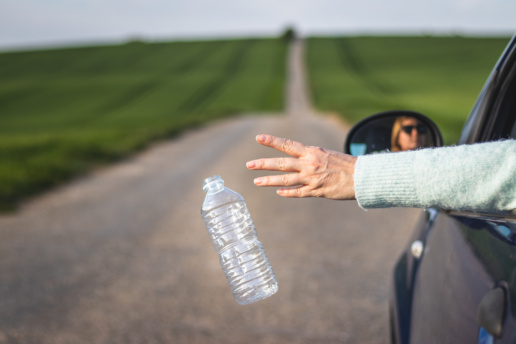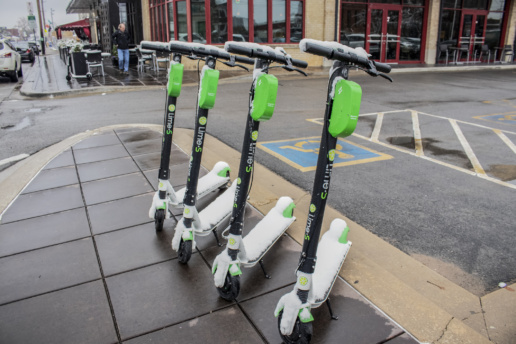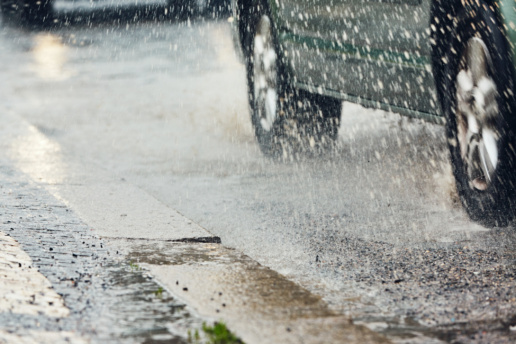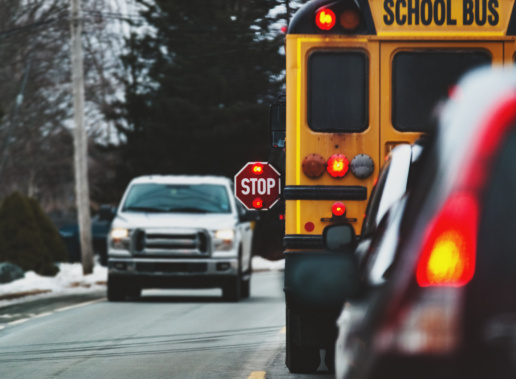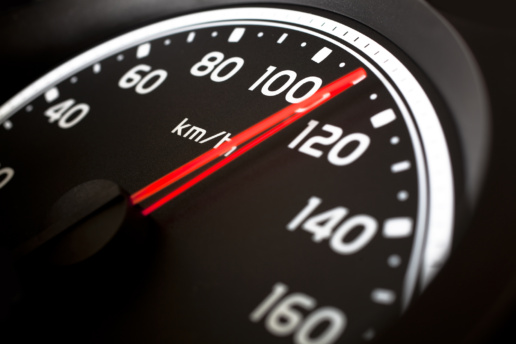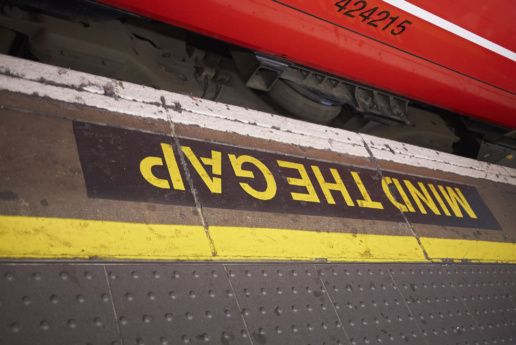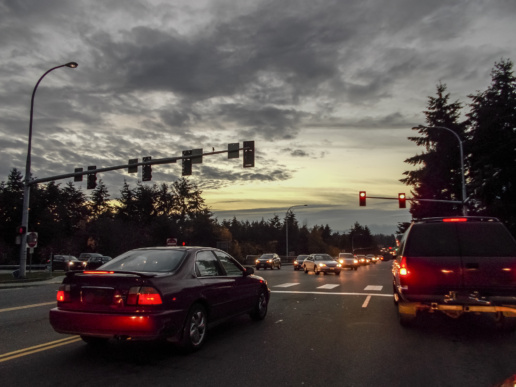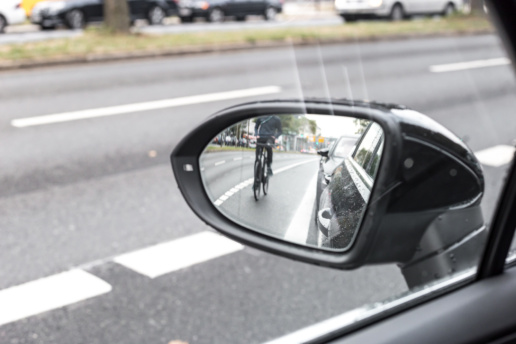Litter Bugs Beware
I have to say, I’m always amazed that just when I think I have run out of blog ideas another one just drops in my lap. Or in this case, on the road.
You can always count on bad drivers to give you material.
Today, my subject is throwing trash out the window of your car.
What Neanderthal would do such a thing, you ask?
Wish I had a picture for you of the person who did it today. But, alas, I can’t break the law by having my phone in my hand to snap a picture while driving.
Someone doing this seriously BLOWS MY MIND.
WHO DOES THIS?
Sadly, looking at the sides of just about every road, apparently a lot of people.
And again, like so many road violations, there are rarely any cops around to punish it. Sad that we even need someone to punish it.
Frankly, it’s the height of laziness, self-centeredness, carelessness, and total lack of respect for this earth. Makes my blood boil.
 You can find the littering law for your state at LitterButt.com (great name, by the way). While this site is specifically devoted to littering with cigarette butts, it did the hard work of compiling the laws in every state.
You can find the littering law for your state at LitterButt.com (great name, by the way). While this site is specifically devoted to littering with cigarette butts, it did the hard work of compiling the laws in every state.
And, in case you are confused, littering IS a crime.
What’s more, Litter-bug.org says, “Litter causes thousands of auto accidents each year, and as many bicycle accidents, with damage to tires and tubes costing millions of dollars.”
Keep America Beautiful conducted a study – the 2009 National Visible Litter Survey and Litter Cost Study. It found:
- Individuals as the primary source of litter. Motorists and pedestrians are littering on roads and highways, in downtown business districts, recreational areas, and beaches.
 Over 51 billion pieces of litter appear on U.S. roadways each year. Most of it, 46.6 billion pieces (91%), is less than four inches. That’s 6,729 items per mile of roadway.
Over 51 billion pieces of litter appear on U.S. roadways each year. Most of it, 46.6 billion pieces (91%), is less than four inches. That’s 6,729 items per mile of roadway.- Tobacco products comprise roughly 38% of ALL U.S. roadway litter in overall aggregate analysis. Paper (22%) and plastic (19%) are the next largest percentages of litter on roads and highways.
- Sidenote: According to AllentownRecycles.org, “the most COMMONLY littered item is the cigarette butt. Many smokers believe that cigarette butts are not litter - and decompose quickly. THIS IS WRONG. The plastic filters can take up to 15 years to decompose!!”
- Most roadway litter -- 76% -- appears to originate from motorists and pedestrians. Individual actions by motorists (52%), pedestrians (22.8%), improperly covered trucks and cargo loads (16.4%), and other behaviors are the source of roadway litter.
Is it really all that difficult to hold on to your trash and drop it in a proper receptacle when you get out of your car?
Resources
Keep American Beautiful: End Littering
National Conference of State Legislatures: States with Littering Penalties
At Litter-Bug.org, you can post your witness account, description, and evidence of littering and dumping! Neighbors, communities, and law enforcement can use Litter-Bug.org data to help prevent and deter future littering and possibly catch perpetrators of illegal dumping activity. And, while I suspect this web site will unfortunately not effect real change, it will at least be cathartic for you.
Scoot On Out of My Way
Lime. Spin. Bird. Jump.
Raise your hand if you’ve ever almost run over someone on one of these:
Yeah, me too.

Kid was on the far side of a Suburban (gigantic SUV) and essentially invisible to me. Nearly ran him down.
This “micro-mobility” trend (yup, you heard that right), according to the National Association of City Transportation Officials, accounted for “84 million trips taken on shared bikes and scooters across the U.S. in 2018” – 38.5 million of which were scooters specifically.
Soooooo…these Razor-style scooters have clearly gained a ton of popularity and can certainly be a great alternative to a) walking and b) driving your big ole-honking-carbon-emitting-SUV.
Unfortunately, the people behind the handle bars of these things are often as bad as the people behind the wheels of their cars.
What, you ask, are the rules of the road for scooters?
It would appear that the laws in the U.S. vary by state and are not yet consistent. In some cases, you must follow the same rules of the road as any other vehicle. In others, there are specific rules related just to scooters. Some cities are banning them altogether.
Generally, E-scooter users are supposed to:
- Be at least 18 years old
- Have a driver's license
- Ride alone
- Wear a helmet
I’m not sure I have ever seen anyone wearing a helmet. Just sayin'.
Here’s what I’d also like to see:
- Get off the sidewalks, especially if you’re traveling over 15 mph.
- Don’t go through red lights.
- Don’t make turns without signaling.
- You're a vehicle, just like a bike, just like a motorcycle. Same road. Same rules.
- You are a whole lot smaller than a lot of SUVs on the road and, thus, are difficult to see in many cases so watch out.
I could go on.
Consumer Reports did a study that shows that at least eight people died while using a rented e-scooter since the fall of 2017, while another 1,500 were injured, including some who were paralyzed.
Bird told Consumer Reports that, “what has immediately become clear is that 75 percent of the known fatalities with shared e-scooters were due to collisions with cars.”
They went on to say, “we are proud supporters of the Vision Zero movement, calling upon cities everywhere to modernize road infrastructure to protect those who choose a more sustainable form of transportation from the dangers caused by cars.”
My sense is, these scooters aren’t going away anytime soon. And, with roads ill-equipped and ill-designed to accommodate them, cars have no choice but to dodge said scooters.
You can certainly argue that we should all share the roads. We should. But who’s going to win in a fight?
Final note, kinda funny:
Resources
All too timely/sad/From ET: YouTube Star Emily Hartridge Dies at 35 in Electric Scooter Collision
I mean, WHAT? Scooter Commuter on Six-Lane Highway
**EXCELLENT READ** Consumer Reports: 8 Deaths Now Tied to E-Scooters
The Washington Post’s opinion on the matter
National Association of City Transportation Officials – 84 Million Trips on Shared Bikes & Scooters
Chicago Sun-Times Editorial: Scooter riders, be more careful out there
**EXCELLENT READ** CBS News: Electric scooters are igniting new laws, liability concerns and even "scooter rage"
Bird Safety | Bird Safety Report | Lime Safety | Jump Safety | Spin Safety
Rain Driving: The Fast and the Slow of It
![]() Rain, rain go away. Come again another day.
Rain, rain go away. Come again another day.![]()
Ok, so everyone knows, driving is even more treacherous when you add rain to the mix.
AAA says that “wet pavement contributes to nearly 1.2 million traffic crashes per year!”
What drives me crazy is both the drivers that don’t slow down enough to account for the rain AND drivers who slow down too much out of an excess of caution.
Yes, people, there is a happy medium to be had.
Most will warn to slow down in the rain; to be sure, it requires extra attention and may very well require that you slow below the posted speed limit.
According to iDriveSafely.com:
“It only takes 1/12th an inch of rain and 35 mph to hydroplane. The roads are more dangerous when rain comes after a dry spell. (Rain slicks the road with accumulated oil and dirt.) But you just need water. Even though most of the oil washes off after one day’s rain, wet roads are dangerous—rainy weather or not.”
But…
The slower speed some choose to go in the rain can be a tad overly cautious and equally dangerous. You don’t have to crawl! And, for goodness sake, if you’re going to crawl, please do it in the right lane.
For those of you who fail to slow down at all in the rain and, further, exceed the posted speed limit, knock it off! See Accidents: There Ain’t Nothing Good Here.
There's no shortage of tips for wet-weather driving on the interwebs. I’ve included several for you here. And, unless you’re part of the car-free movement, most of these tips should be pretty obvious to you.
There are a few interesting factoids though.
Like, per How Stuff Works, don’t drive toward the sides of the road in rain because there is more water there. Roads are built to be highest in the middle.
Anyhoo…peruse these resources because it never hurts to be informed.
I'm interested to hear your thoughts. Am I right? Am I wrong? What am I missing? Comment below!
Resources
Vehicle Virgins: How to Drive Safely in the Rain (video)
Ford Extreme Weather Driving Tips: How to Drive in Heavy Rain (video)
AAA’s Guide to Wet-Weather Driving Techniques – Get a Grip
AAA Exchange Wet-Weather Driving Tips
IDriveSafely.com's 4 Tips for Driving in Rain
10 Crucial Things to Know Before You Start Driving In The Rain
While this article is for beginner drivers, I think we all could use a little refresher.
WikiHow: Driving Safely in the Rain
How Stuff Words: 5 Completely Wrong Ways to Drive in the Rain
School Bus? STOP!
I just watched a rather disturbing report on the “Today Show” about a driver in Minnesota who completely ignored the red flashing lights and extended stop arm protruding from the side of a school bus and nearly ran over a child crossing the road to board.
Idiot. And, near murderer. Oh, and the jackass had the gall to blow their horn at the kid.
Sadly, if you Google this type of thing, there are numerous stories of the same thing, some of them ending in death.
Straight from the driver’s manual:
“If a school vehicle has stopped on the roadway and is operating the alternately flashing red lights, the driver of ANY vehicle following OR approaching the school vehicle shall:
- Stop at least 20 feet from the rear of the school vehicle, if approaching the school vehicle from its rear; or
- At least 20 feet from the front of the school vehicle, if approaching the school vehicle from its front.
The driver of any vehicle following or approaching the school vehicle may not proceed until the school vehicle resumes motion or the alternately flashing red lights are deactivated. This does not apply to the driver of a vehicle on a physically divided highway.”
And, at the risk of being Captain Obvious, if you also see the extended stop arm, STOP!
Read about the Minnesota driver and their punishment here.
And just in case you don’t think anything bad will happen, here’s another horrible story where three siblings were killed trying to board their bus in Indiana.
The National Highway Transportation Safety Administration encourages drivers to be familiar with “the 'flashing signal light system' that school bus drivers use to alert motorists of pending actions:
Yellow flashing lights indicate the bus is preparing to stop to load or unload children. Motorists should slow down and prepare to stop their vehicles.
Red flashing lights and extended stop arms indicate the bus has stopped and children are getting on or off. Motorists must stop their cars and wait until the red lights stop flashing, the extended stop-arm is withdrawn, and the bus begins moving before they can start driving again.”
Here is a useful graphic to follow when it comes to school busses and your obligation to stop:

When it comes to school busses, whether you are following or approaching, you will, more often than not, have to stop.
Deal with it.
Resources:
You can find the specific law in your state using AAA’s Digest of Motor Laws: https://drivinglaws.aaa.com/tag/school-buses/
NHTSA School Bus Safety: https://www.nhtsa.gov/road-safety/school-bus-safety
Ridiculous Roundabouts
It would appear VERY FEW PEOPLE in America know how to properly navigate a traffic circle, or roundabout.
If I have to sit behind another person who either won’t go or just inches out like they’re dipping their toe in a freezing cold pool, I’m gonna scream!
Lots of different sources say what WikiHow does:
Roundabouts “are increasingly being used because they ease congestion, cost less to operate, reduce accidents by roughly half (really?!), and use less energy than traditional light-operated intersections.”
All fairly compelling reasons I’d say.
So, it doesn’t seem like they’re going away anytime soon so y’all better learn to how to do the roundabout right!
Here’s an excellent video from GEICO (yup) on how to properly navigate the dreaded traffic circle:
How Stuff Works covers the history of roundabouts, their design, the benefits and more tips on how to drive in them in case you just can’t get enough.
At the end of the day, you’ve gotta get out there when an opening presents itself. You can’t sit there hoping for an empty circle cause it ain’t gonna come!
Resources
WikiHow: How to Navigate a Roundabout
How Stuff Works: How Roundabouts Work
Highway as Daytona International Speedway
You may wonder why I haven’t written about this rather obvious topic before now.
Well, let’s just say, I fancy myself an “efficient” driver. And by efficient, I mean I drive with focus, and without hesitation.
Ok, I speed.
But I do have my limits. (You see what I did there?!)
I have heard through the grapevine that most cops won’t pull you over if you are going 11 miles over the posted speed limit or less. Is that urban legend? Don’t know.
I do know that there are not enough cops on the road to properly manage all the bad stuff drivers do – speeding and otherwise. I include myself here.
BUT, BIG BUT HERE…
It blows my mind when I see cars FLYING down the highway, and, worse, WEAVING in and out of lanes around other cars just to maintain their RIDICULOUS and DANGEROUS speed.
And while this is not in the U.S., it does illustrate my point rather well:
You’d think it was the dang Daytona International Speedway! In fact, Daytona looks safer!
You are endangering your own life, yes.
But, far more important, you are endangering the lives of the people in the cars around you – me included. And, THAT, dudes, is crossing the line.
The National Highway Transportation Safety Administration web site reviews the myriad issues related to speeding including pointing out this fun fact:
In 2017 [the most recent stats I can find], speeding killed 9,717 people, accounting for more than a quarter (26%) of all traffic fatalities that year.
Consider this frightening note:
“…going just ten miles over the speed limit can make the difference between life and death. In a crash, the severity of injuries increases dramatically depending on the speed of a driver—a pedestrian hit at 30 mph has a 60 percent chance of survival, while someone hit at 40 mph only has a 40 percent chance of living.”
I can preach about us all slowing down. And we should. But will we?
This I know for sure: you will never look back and say, “I wish I didn’t slow down.”
And, getting a speeding ticket, getting in an accident, or killing someone will NEVER be worth it.
I’m sure I’ll write on this topic a million more times. There’s lots to cover.
Resources
NHTSA: Safety Study Reducing Speeding-Related Crashes Involving Passenger Vehicles
NHTSA: Crash Stats
NHTSA: Speeding
CBS News: Speeding kills nearly as many people as drunk driving, NTSB says
Curbed.com takes an in depth look at the issue in this article: U.S. traffic death increase caused by speeding
[WARNING] Watch this video only if you think you can handle it.
The Hazards of Hazard Lights
How drivers use their hazard lights doesn’t drive me quite as crazy as a lot of other things on the roads. But I am perplexed when I see people driving normally – seemingly – with their hazard lights on. Doesn’t that sort of defeat the purpose for which they are intended?
Robert Thomson of the Washington Post says, “The laws on hazard lights vary from state to state, but common sense says that when you put them on, you are declaring that you are a hazard to other motorists. They are meant to be used when you have an emergency.”
Many states say you must be pulled off the road in order to legally use them, while other states aren’t as strict.
This article provides a handy list of state laws regarding the use of hazard lights. States are broken down into three categories:
- those who allow use while driving
- those who prohibit use while driving
- those who allow use while driving in emergency situations
USE THEM when your car has broken down and you’re waiting to be towed or if you're driving in a funeral procession.
AVOID USING THEM when driving in bad weather, bad traffic or (and you know who you are) when you are parking illegally!
The takeaway here? Know the law in your state and don’t be randomly tooling down the highway with your hazards on for no legit reason!
Resources
Firestone: Are you using your hazard lights the right way?
Washington Post: Here’s the proper way to use your emergency flashers
Mind the Ginormous Gap
I like to think of myself as an “efficient” driver. I maneuver around other cars on the road – safely, of course – to keep moving toward my destination.
Often times, I find myself in the left, AKA fast, lane.
And there is little else that drives me quite as crazy – ok, who am I kidding? – than people who are in front of me and FAIL to mind the humongous, very large, often enormous gap between them and the car in front of them. [Yes, minding the gap is also a term used in Britain when you are stepping on and off the metro.]
Let me explain.
In driver’s ed, we’re taught to maintain a safe distance from the car in front of us, and the rule of thumb is one car length for every 10 miles per hour you are traveling. So, if you’re driving 60 mph, you should be six car lengths behind the car in front of you.
Now, I think it is safe to say that pretty much no one stays that far back on a regular basis. But, hopefully, you maintain a safe distance – one that allows you to come to a safe stop should the car in front of you stop abruptly and unexpectedly.
The driver's manual suggests that you keep a 3 to 4 second distance. Wikipedia recommends the 2-second rule.
But here’s where I get irritated.
I’m traveling in the left lane (because there is so much traffic on the road, that the left lane must be used) and the car in front of me has NO ONE in front of them for oodles of car lengths.
It is at that point that they need to MOVE OUT OF THE LEFT LANE!
So, yes, this is a sequel to my “The Left Lane: Chance are you need to get out of it” post.
Minding the gap doesn’t have to be about speed either.
You leave a huge gap between you and the car in front of you during rush hour traffic and what happens? Other cars fill that gap. It encourages changing of lanes, which causes cars to slow down, which makes everyone behind you wait longer and longer to get to their destination. #truth
Look, it’s a free country. You are free to leave a ginormous gap. Just don’t do it in the left lane.
Special Note: I do recognize this is a first world problem.
Resources:
In Control is a non-profit organization that offers state certified crash prevention training to all drivers.
Wikipedia recommends the Two-Second Rule.
Traffic Light Hang-Backers
Have you ever sat at a red traffic light behind someone who is too far back from the stop line? And, the light stays red and stays red and stays red….?
According to Instructables.com, “At most traffic lights and turn signals, you will notice a loop of wire buried in the pavement of the road near the stop line. ... Most motorcycles, scooters, bicycles and small cars don't have enough conductive material to trigger these loops and change the traffic light.”
Or, if you are too far back to trigger the loop, IT WON’T CHANGE!
This drives me insane!!!
(FYI…This typically occurs in the suburbs more so than in cities. In cities, light timers are often the norm.)
Automate Systems says that, “…in the suburbs and up county roads, traffic signal sensors (detectors) are usually preferred because they not only manage the inconsistent traffic flow effectively, but also detect when cars arrive at intersections, when several cars are stacked at an intersection and when cars have entered turn lanes.
“These sensors use different technologies, from induction loops, microwave radar, cameras, lasers to rubber hoses filled with air.”
This video has a super cool hack to getting lights to change to green for motorcycles, scooters, bikes and small cars:
But here’s where you hang-backers should pay attention: WikiHow.com brilliantly shows you how to properly position your car to get the light to change:
“Pull up to the stop line in a car. Drive your car up to the stop bar or line, which is a line perpendicular to your car painted just in front of the crosswalk markings at most intersections.
-If you see grooves in the road that indicate the presence of inductive loops, make sure your car is positioned directly over those loops so it gets detected.
-If you see no signs of inductive loops, or you see a camera control system, just make sure that you are positioned in the middle of the street lane, not further forward than the stop line and not too far back from it.
-[OFFENDERS, PLEASE NOTE THIS>] It’s especially important to position your car not too far forward or backward when in a left turning lane, as these often will have their own detector that signals a protected left turn signal.”
So, please, do us all (me) a favor, and don’t be one of those people that for some inexplicable reason sits too far back from the stop line thus preventing the light from changing to green and holding us all up.
We've all got places to be, people!
Resources:
Instructables | Automate Systems| How Stuff Works | Wikihow
Bicycles: You Have the SAME Rights, Responsibilities as Cars
Many – and when I say many, I mean many – years ago, I was driving my dad to work (because I wanted to be able to use his Honda Accord to drive to school, of course) when, as I passed through a green light, I was screamed at by a college student on her bike who wanted to turn left in front of me.
“You have to stop for me!!!” she yelled.
In fact, she was wrong. She clearly didn’t know the rules of the road for cyclists: you essentially have the same rules as a car.
She mistakenly thought a pedestrian and a bicyclist were the same.
They are not.
In fact, she was supposed to yield to me.
I wonder if she ever figured out the correct rule. Did she feel bad about screaming at me?
I guess I’ll never know. But I did get to drive my dad’s car to school that day.
 For cars, there are a handful of laws mostly surrounding the distance you keep from bikes when passing them on the road. The norm is this:
For cars, there are a handful of laws mostly surrounding the distance you keep from bikes when passing them on the road. The norm is this:
“Drivers passing a bicycle must pass with a space of 3 feet between the motor vehicle and the bicycle.”
For bicyclists, the law mostly pertains to whether or not a particular state has a helmet law. Surprisingly, many don’t.
In Alaska for example, operators of bicycles must obey the motor vehicle laws. Cyclists must ride with traffic. And, there is no helmet requirement.
You can find out the laws for your state here: https://drivinglaws.aaa.com/tag/bicycles/
In Maryland for another example, the Driver’s Manual says, “By Maryland law, bicycles are vehicles. Bicyclists are authorized users of the roadway and have rights-of-way and the same duty to obey all traffic signals as motorists.”
I think it is safe to say that bicyclists and drivers have a few additional laws they’d like to see enacted. We have to share the roadway, after all.
#howmanytimeshaveyouseenabicyclistrunthestopsign
According to John Rennie Short in an article for The Conversation, “Across the nation, cyclist fatalities have increased by 25 percent since 2010 and pedestrian deaths have risen by a staggering 45 percent. More people are being killed because cities are encouraging residents to walk and bike, but their roads are still dominated by fast-moving vehicular traffic. As my research has shown, this shifting mix can be deadly.”
At the end of the day, the goal is for EVERYONE to get home safely.
According to the NHTSA, “For drivers, sharing the road begins with understanding that bicyclists have the same rights and responsibilities as you.
“Treat bicyclists as you would other drivers and be as aware of them in traffic as you are of vehicles. Pass bicyclists as you would vehicles—when it’s safe to move over into an adjacent lane. Give them sufficient room. Do not pass too closely.”
And…
“Just like vehicle drivers, bicyclists must obey street signs, signals, and road markings. Always ride with traffic. Ride defensively, assuming others cannot see you. Ride attentively by never allowing yourself to be distracted by music, an electronic device, or anything else that takes your eyes off the road.” Good advice for drivers too, I’d say.
Honestly, bicyclists don’t get me as riled up as many other things on the roads. But remember:
Same roads. Same rules. Same rights.
Resources:
The Conversation - US: Why US cities are becoming more dangerous for cyclists and pedestrians
Bike League | American Bicycling Education Association
National Highway Transportation Safety Administration - Share the Road
A Guide for Drivers and Bicyclists to Properly Share the Road
Have I mentioned how much I love AAA? This Share the Road pdf is excellent!

